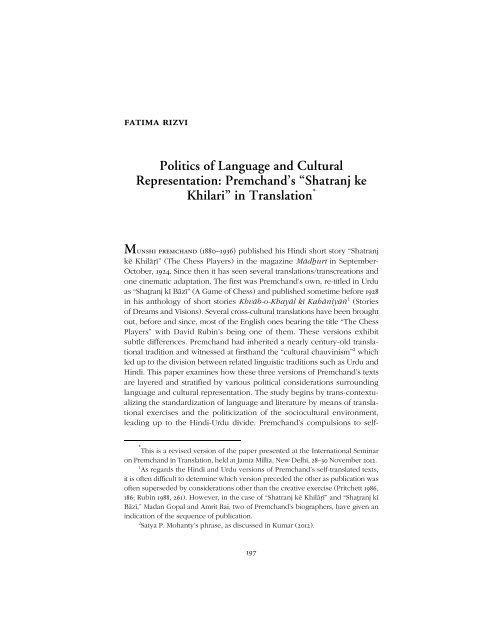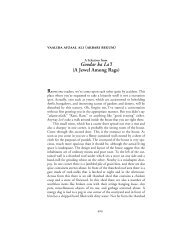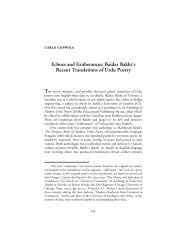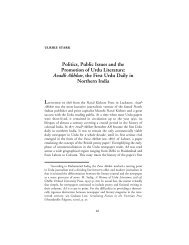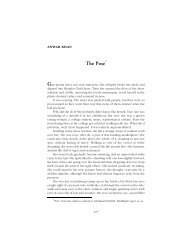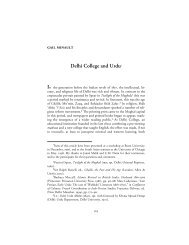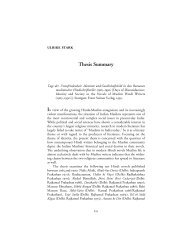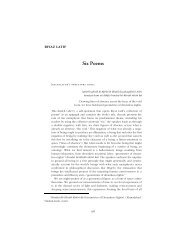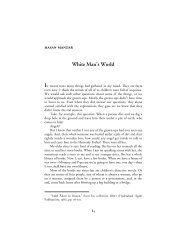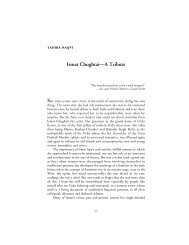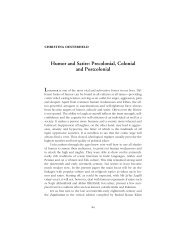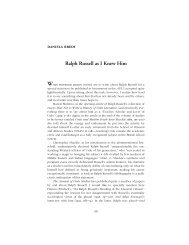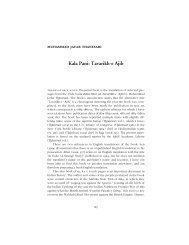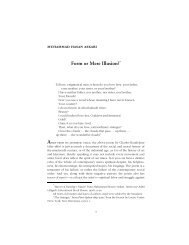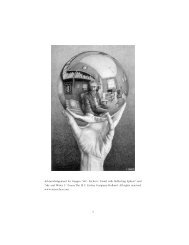Premchand's âShatranj ke Khilariâ in Translation - the Annual of Urdu ...
Premchand's âShatranj ke Khilariâ in Translation - the Annual of Urdu ...
Premchand's âShatranj ke Khilariâ in Translation - the Annual of Urdu ...
Create successful ePaper yourself
Turn your PDF publications into a flip-book with our unique Google optimized e-Paper software.
fatima rizvi<br />
Politics <strong>of</strong> Language and Cultural<br />
Representation: Premchand’s “Shatranj <strong>ke</strong><br />
Khilari” <strong>in</strong> <strong>Translation</strong> *<br />
Munshi premchand (1880–1936) published his H<strong>in</strong>di short story ìShatranj<br />
kē Khilāṛīî (The Chess Players) <strong>in</strong> <strong>the</strong> magaz<strong>in</strong>e Mādẖurī <strong>in</strong> September-<br />
October, 1924. S<strong>in</strong>ce <strong>the</strong>n it has seen several translations/transcreations and<br />
one c<strong>in</strong>ematic adaptation. The first was Premchandís own, re-titled <strong>in</strong> <strong>Urdu</strong><br />
as ìSharanj kī Bāzīî (A Game <strong>of</strong> Chess) and published sometime before 1928<br />
<strong>in</strong> his anthology <strong>of</strong> short stories Khvāb-o-Khayāl kī Kahāniyāñ 1 (Stories<br />
<strong>of</strong> Dreams and Visions). Several cross-cultural translations have been brought<br />
out, before and s<strong>in</strong>ce, most <strong>of</strong> <strong>the</strong> English ones bear<strong>in</strong>g <strong>the</strong> title ìThe Chess<br />
Playersî with David Rub<strong>in</strong>ís be<strong>in</strong>g one <strong>of</strong> <strong>the</strong>m. These versions exhibit<br />
subtle differences. Premchand had <strong>in</strong>herited a nearly century-old translational<br />
tradition and witnessed at firsthand <strong>the</strong> ìcultural chauv<strong>in</strong>ismî 2 which<br />
led up to <strong>the</strong> division between related l<strong>in</strong>guistic traditions such as <strong>Urdu</strong> and<br />
H<strong>in</strong>di. This paper exam<strong>in</strong>es how <strong>the</strong>se three versions <strong>of</strong> Premchandís texts<br />
are layered and stratified by various political considerations surround<strong>in</strong>g<br />
language and cultural representation. The study beg<strong>in</strong>s by trans-contextualiz<strong>in</strong>g<br />
<strong>the</strong> standardization <strong>of</strong> language and literature by means <strong>of</strong> translational<br />
exercises and <strong>the</strong> politicization <strong>of</strong> <strong>the</strong> sociocultural environment,<br />
lead<strong>in</strong>g up to <strong>the</strong> H<strong>in</strong>di-<strong>Urdu</strong> divide. Premchandís compulsions to self-<br />
* This is a revised version <strong>of</strong> <strong>the</strong> paper presented at <strong>the</strong> International Sem<strong>in</strong>ar<br />
on Premchand <strong>in</strong> <strong>Translation</strong>, held at Jamia Millia, New Delhi, 28–30 November 2012.<br />
1 As regards <strong>the</strong> H<strong>in</strong>di and <strong>Urdu</strong> versions <strong>of</strong> Premchandís self-translated texts,<br />
it is <strong>of</strong>ten difficult to determ<strong>in</strong>e which version preceded <strong>the</strong> o<strong>the</strong>r as publication was<br />
<strong>of</strong>ten superseded by considerations o<strong>the</strong>r than <strong>the</strong> creative exercise (Pritchett 1986,<br />
186; Rub<strong>in</strong> 1988, 261). However, <strong>in</strong> <strong>the</strong> case <strong>of</strong> ìShatranj kē Khilāṛīî and ìSharanj kī<br />
Bāzī,î Madan Gopal and Amrit Rai, two <strong>of</strong> Premchandís biographers, have given an<br />
<strong>in</strong>dication <strong>of</strong> <strong>the</strong> sequence <strong>of</strong> publication.<br />
2 Satya P. Mohantyís phrase, as discussed <strong>in</strong> Kumar (2012).<br />
197
198 • The <strong>Annual</strong> <strong>of</strong> <strong>Urdu</strong> Studies, No. 28<br />
translate are briefly reviewed. It <strong>the</strong>n conducts a close textual analysis <strong>of</strong><br />
Premchandís orig<strong>in</strong>al H<strong>in</strong>di story as well as his self-translated/transcreated<br />
ìSharanj kī Bāzīî <strong>in</strong> <strong>Urdu</strong> to analyze <strong>the</strong> ma<strong>in</strong> differentiat<strong>in</strong>g aspects which<br />
emphasize <strong>the</strong> politics <strong>of</strong> l<strong>in</strong>guistic and cultural representation. This is followed<br />
by focus<strong>in</strong>g on translational techniques/strategies <strong>in</strong> Rub<strong>in</strong>ís crosscultural<br />
translation ìThe Chess Players.î The study concludes with an estimation<br />
<strong>of</strong> Premchandís texts as depictive <strong>of</strong> <strong>the</strong> decadence <strong>of</strong> erstwhile<br />
Awadh.<br />
<strong>Translation</strong>al Tradition and Sociopolitical Culture<br />
<strong>Translation</strong> from <strong>the</strong> orig<strong>in</strong>al/source to <strong>the</strong> target/receptor language is a<br />
semiotic/<strong>in</strong>ter-semiotic exercise <strong>in</strong>volv<strong>in</strong>g, extr<strong>in</strong>sically, a change <strong>of</strong> script<br />
and, <strong>in</strong>tr<strong>in</strong>sically, a process <strong>of</strong> cultural, semantic and l<strong>in</strong>guistic decod<strong>in</strong>g<br />
and recod<strong>in</strong>g. It also <strong>in</strong>volves recension, abridgement, reorder<strong>in</strong>g, transcreation<br />
and adaptation. <strong>Translation</strong>al exercises are not new, but with<strong>in</strong><br />
subcont<strong>in</strong>ental India <strong>the</strong> n<strong>in</strong>eteenth century saw a surge <strong>in</strong> translational<br />
exercises which contributed significantly towards <strong>the</strong> development and<br />
standardization <strong>of</strong> both <strong>the</strong> dialectal l<strong>in</strong>guistic forms and <strong>the</strong> traditional<br />
literary genres <strong>of</strong>, especially, <strong>Urdu</strong> prose and fiction.<br />
Institutions such as Fort William College, Calcutta, (established 1800)<br />
and Delhi College (established ca. 1827) were set up as part <strong>of</strong> <strong>the</strong> colonial<br />
practice to dissem<strong>in</strong>ate knowledge <strong>of</strong> <strong>the</strong> Orient. <strong>Urdu</strong> was <strong>the</strong> mediat<strong>in</strong>g<br />
language at <strong>the</strong> Delhi College. <strong>Translation</strong>s underta<strong>ke</strong>n at <strong>the</strong>se <strong>in</strong>stitutions<br />
were osmotic <strong>in</strong> <strong>in</strong>fluenc<strong>in</strong>g <strong>the</strong> creation <strong>of</strong> modern <strong>Urdu</strong> literature and<br />
<strong>in</strong>strumental <strong>in</strong> cultivat<strong>in</strong>g a long stand<strong>in</strong>g <strong>in</strong>terest <strong>in</strong> <strong>Urdu</strong> prose. Besides<br />
Persian, Sanskrit, <strong>Urdu</strong> and H<strong>in</strong>di texts, <strong>the</strong> Naval Kishore Press, Lucknow<br />
(established 1858) also undertook translation <strong>of</strong> many English novels which<br />
were ìIndianizedî to accord with <strong>the</strong> Subcont<strong>in</strong>ental milieu. In <strong>the</strong> aftermath<br />
<strong>of</strong> <strong>the</strong> Upris<strong>in</strong>g <strong>of</strong> 1857, <strong>Urdu</strong> periodicals and papers became platforms<br />
for discursive, <strong>in</strong>tellectual, cultural and literary debates, <strong>the</strong>reby facilitat<strong>in</strong>g<br />
transactions between <strong>the</strong> East and <strong>the</strong> West. Thus Avadẖ Akhbār (1859),<br />
Avadẖ Panč (1877), and Tehẕībuíl-Akhlāq (1870) also published translations<br />
<strong>of</strong> European, especially English literature, provid<strong>in</strong>g new models for <strong>Urdu</strong><br />
writers. As aga<strong>in</strong>st <strong>the</strong> highly evolved poetic genres <strong>of</strong> <strong>Urdu</strong> literature, <strong>the</strong><br />
relatively younger prose forms <strong>of</strong> <strong>the</strong> <strong>Urdu</strong> afsāna (short story) and <strong>the</strong><br />
novel evolved from <strong>the</strong> conflation <strong>of</strong> several m<strong>in</strong>or and major <strong>in</strong>digenous<br />
genres, <strong>in</strong>flected with Western <strong>in</strong>fluence due to <strong>the</strong> various translational<br />
processes. The popularity <strong>of</strong> <strong>the</strong>se relatively new genres led to <strong>the</strong> absorption<br />
or gradual fad<strong>in</strong>g out <strong>of</strong> several older <strong>in</strong>digenous genres.
Fatima Rizvi • 199<br />
The mid-n<strong>in</strong>eteenth century witnessed dist<strong>in</strong>ctive efforts emphasiz<strong>in</strong>g<br />
<strong>the</strong> separateness <strong>of</strong> modern H<strong>in</strong>di and <strong>Urdu</strong>, <strong>in</strong> spite <strong>of</strong> <strong>the</strong>ir common orig<strong>in</strong>s<br />
from rural dialectal l<strong>in</strong>guistic forms such as Braj, Awadhi, Maithili and<br />
Bhojpuri and <strong>the</strong> urban khari boli. Amrit Rai traces <strong>the</strong> bifurcation <strong>of</strong> <strong>Urdu</strong><br />
and H<strong>in</strong>di to <strong>the</strong> Mughal courtly practice <strong>in</strong> <strong>the</strong> late eighteenth century,<br />
differentiat<strong>in</strong>g between a culturally evolved, heavily Persianized idiom,<br />
based on correctness <strong>of</strong> usage and meant for <strong>the</strong> élite Muslims and H<strong>in</strong>dus<br />
and <strong>the</strong> nobility and o<strong>the</strong>r varieties <strong>of</strong> dialectal usage (see Kumar 2012,<br />
n.p.). However, Sanjay Kumar differs by observ<strong>in</strong>g that this language was<br />
not based on religious differences; that <strong>the</strong> greatest differentiator between<br />
this and <strong>the</strong> o<strong>the</strong>r dialectal varieties such as Awadhi and Braj was that it<br />
was urban while <strong>the</strong> o<strong>the</strong>rs were rural; that only <strong>the</strong> élite H<strong>in</strong>dus and<br />
Muslims attached to <strong>the</strong> courts used it; and that script was not an issue<br />
(ibid.). He also cites colonial language policies, based on religious and<br />
cultural differences, as <strong>the</strong> earliest patterns emphasiz<strong>in</strong>g separateness and<br />
Dr. John Borthwick Gilchrist, Pr<strong>of</strong>essor <strong>of</strong> H<strong>in</strong>dustanee at Fort William<br />
College, as <strong>the</strong> person who first identified language with script and religion.<br />
Kumar notes that Gilchrist promoted two different styles as two different<br />
languagesóH<strong>in</strong>dustanee <strong>in</strong> Persian or Nastaliq script, which became <strong>Urdu</strong>,<br />
and H<strong>in</strong>davi/H<strong>in</strong>dui <strong>in</strong> <strong>the</strong> Devanagari script, which, purged <strong>of</strong> all foreign<br />
<strong>in</strong>fluences, evolved <strong>in</strong>to modern H<strong>in</strong>di (ibid.).<br />
This view is similar to that <strong>of</strong> <strong>the</strong> historian Tara Chand, who perceives<br />
ì<strong>the</strong> zeal for f<strong>in</strong>d<strong>in</strong>g dist<strong>in</strong>ctionsî on <strong>the</strong> part <strong>of</strong> some <strong>of</strong> <strong>the</strong> pr<strong>of</strong>essors at<br />
Fort William College at <strong>the</strong> base <strong>of</strong> <strong>the</strong> bifurcation (qtd. <strong>in</strong> Faruqi 2001, 54).<br />
Faruqi cites Gilchrist as <strong>the</strong> person who first sowed <strong>the</strong> seeds <strong>of</strong> l<strong>in</strong>guistic<br />
separatism (ibid., 59) and cites (a) Francis Rob<strong>in</strong>son as designat<strong>in</strong>g <strong>the</strong> 1880s<br />
and 1890s as <strong>the</strong> period <strong>of</strong> <strong>the</strong> communalization <strong>of</strong> <strong>the</strong> languages and (b)<br />
Bharatendu Harishchandraís <strong>in</strong>vectives to <strong>in</strong>dicate <strong>the</strong> serious communal<br />
byplay that was underway dur<strong>in</strong>g this period (ibid., 57–58). He notes that,<br />
as <strong>Urdu</strong> became <strong>in</strong>creas<strong>in</strong>gly identified as a Muslim language, it was denigrated<br />
on ìmoralî and ìreligiousî grounds; that users <strong>of</strong> <strong>Urdu</strong> were perforce<br />
made to feel guilty about its orthographic ambiguities and foreign orig<strong>in</strong>s;<br />
that <strong>the</strong> Devanagari script was claimed to be superior to <strong>the</strong> <strong>Urdu</strong> script;<br />
that cont<strong>in</strong>ually, proactive measures were underta<strong>ke</strong>n to popularize H<strong>in</strong>di<br />
while <strong>in</strong>vectives marg<strong>in</strong>alized <strong>the</strong> written and spo<strong>ke</strong>n idiom <strong>of</strong> <strong>Urdu</strong> (ibid.,<br />
45–56).<br />
Paul Brassís remark that <strong>the</strong> defenders <strong>of</strong> <strong>Urdu</strong> were too slow <strong>in</strong> <strong>the</strong>ir<br />
response (1974, 136) is corroborated by Faruqi who also notes that <strong>the</strong><br />
serious ramifications <strong>of</strong> this l<strong>in</strong>guistic, cultural and communal bifurcation<br />
were anticipated by Sir Syed Ahmad Khan, who played a <strong>ke</strong>y role <strong>in</strong> <strong>the</strong><br />
defense <strong>of</strong> <strong>Urdu</strong> dur<strong>in</strong>g this period, but <strong>the</strong> process, already set <strong>in</strong> motion,
200 • The <strong>Annual</strong> <strong>of</strong> <strong>Urdu</strong> Studies, No. 28<br />
seemed irreversible (ibid., 58).<br />
Faruqi quotes Premchandís public addresses made at <strong>the</strong> Arya Bhasha<br />
Sammelan <strong>in</strong> Lahore (1936) and <strong>the</strong> Daksh<strong>in</strong> Bharat H<strong>in</strong>di Prachar Sabha<br />
<strong>in</strong> Madras (1934) to establish that although he accepted <strong>the</strong> common orig<strong>in</strong>s<br />
<strong>of</strong> <strong>the</strong> two languages and advocated <strong>the</strong> use <strong>of</strong> a simplified H<strong>in</strong>dustani<br />
idiom which would stride Sanskritic H<strong>in</strong>di and Persianized <strong>Urdu</strong>, he too<br />
emphasized <strong>the</strong> foreignness <strong>of</strong> <strong>Urdu</strong> and swam with <strong>the</strong> tide (ibid., 21–22,<br />
62). Premchand specified that he was not concerned with <strong>the</strong> politics <strong>of</strong><br />
<strong>the</strong> s<strong>in</strong>gularity <strong>of</strong> Sanskritic H<strong>in</strong>di as <strong>the</strong> national language. He believed <strong>in</strong><br />
<strong>the</strong> essential closeness <strong>of</strong> H<strong>in</strong>di, H<strong>in</strong>dustani and <strong>Urdu</strong> and believed that<br />
l<strong>in</strong>guistic pluralism was <strong>in</strong> fact an <strong>in</strong>dication <strong>of</strong> <strong>the</strong> evolution <strong>of</strong> language<br />
(1967, 100–33).<br />
Premchand and Self-<strong>Translation</strong><br />
Dhanpat Rai Srivastava (Premchand), also known as Nawab Rai, began his<br />
literary career as a writer <strong>of</strong> <strong>Urdu</strong> fiction because <strong>Urdu</strong> was <strong>the</strong> prevail<strong>in</strong>g<br />
medium <strong>of</strong> literary expression dur<strong>in</strong>g much <strong>of</strong> <strong>the</strong> n<strong>in</strong>eteenth century. He<br />
had imbibed this tradition <strong>in</strong> <strong>the</strong> course <strong>of</strong> his education. By about 1900,<br />
his social and political awareness gradually matured <strong>in</strong>to a nationalist consciousness.<br />
However, from 1913–1915 he steadily gave up <strong>Urdu</strong> <strong>in</strong> preference<br />
for H<strong>in</strong>di (Rai 2002, 388). Dalmia observes that Premchand switched to<br />
publish<strong>in</strong>g his works <strong>in</strong> H<strong>in</strong>di early <strong>in</strong> his career, as H<strong>in</strong>di had a larger<br />
mar<strong>ke</strong>t (2010b, 494). Premchand confided <strong>in</strong> a letter addressed to Munshi<br />
Dayanarayan Nigam (26 June 1915) that he had got ìlittle benefitî from <strong>the</strong><br />
art <strong>of</strong> writ<strong>in</strong>g (qtd. <strong>in</strong> Gopal 1964, 108). Economically this was a lean period.<br />
Around <strong>the</strong> same time, he resumed study<strong>in</strong>g, negotiated tak<strong>in</strong>g over editorship<br />
<strong>of</strong> Zamāna, and sent out stories to both H<strong>in</strong>di and <strong>Urdu</strong> journals.<br />
He received greater appreciation from H<strong>in</strong>di periodicals, newspapers and<br />
journals and confided <strong>in</strong> Nigam: ìI th<strong>in</strong>k writ<strong>in</strong>g <strong>in</strong> <strong>Urdu</strong> wonít do. Li<strong>ke</strong><br />
<strong>the</strong> late Balmukand Gupta, I shall have to pass <strong>the</strong> last days <strong>of</strong> my life <strong>in</strong><br />
writ<strong>in</strong>g H<strong>in</strong>di. Is <strong>the</strong>re a H<strong>in</strong>du who has dist<strong>in</strong>guished himself <strong>in</strong> <strong>Urdu</strong>?<br />
And if none has succeeded, how can I?î (ibid., 113).<br />
Premchand self-translated short stories and novels on a regular basis,<br />
convert<strong>in</strong>g H<strong>in</strong>di and <strong>Urdu</strong> <strong>in</strong>to source and target languages. Such cont<strong>in</strong>ual<br />
exercises could have been prompted by <strong>the</strong> divergent systemic sociopolitical<br />
and cultural patterns and <strong>the</strong> diverse artistic and political objectives<br />
and priorities precipitated by <strong>the</strong> breakdown <strong>of</strong> <strong>the</strong> cultural and l<strong>in</strong>guistic<br />
syncretism <strong>of</strong> once related traditions. The cultural dom<strong>in</strong>ance and élitist<br />
nature <strong>of</strong> <strong>the</strong> already standardized <strong>Urdu</strong> <strong>in</strong> multil<strong>in</strong>gual nor<strong>the</strong>rn India could
Fatima Rizvi • 201<br />
well have been <strong>the</strong> reason for Premchandís cont<strong>in</strong>ued self-translations/<br />
transcreations despite his pr<strong>of</strong>essed preference for <strong>the</strong> new national language.<br />
Several o<strong>the</strong>r reasons may be ascribed to <strong>the</strong>se exercises which created<br />
a large corpus <strong>of</strong> bil<strong>in</strong>gual oeuvre. Perhaps, <strong>in</strong>itially, he took to writ<strong>in</strong>g <strong>in</strong><br />
H<strong>in</strong>di to avoid <strong>the</strong> proscriptive eye <strong>of</strong> <strong>the</strong> government. His cont<strong>in</strong>u<strong>in</strong>g to<br />
do so may also be ascribed to his be<strong>in</strong>g <strong>in</strong> governmental service. The new<br />
<strong>of</strong>ficial language be<strong>in</strong>g H<strong>in</strong>di, he envisioned <strong>the</strong> need to develop a body<br />
<strong>of</strong> literature <strong>in</strong> this modern language. It is also li<strong>ke</strong>ly that <strong>the</strong> unadorned,<br />
simple and direct style <strong>of</strong> modern H<strong>in</strong>di prose, still <strong>in</strong> its evolutionary stage,<br />
as opposed to <strong>the</strong> ornate and verbose style <strong>of</strong> <strong>Urdu</strong>, was better suited to<br />
deliver<strong>in</strong>g <strong>the</strong> message <strong>of</strong> psychological, social and political realism on<br />
which his stories were centered. Premchand believed that <strong>in</strong> <strong>the</strong> current<br />
politically and socially turbulent times, literature ought to embody a moral<br />
purpose and express true emotions and realities (ibid., 278). Hence realism<br />
ought to precede craftsmanship. As is evident from <strong>the</strong> Presidential address<br />
he delivered at <strong>the</strong> <strong>in</strong>augural session <strong>of</strong> <strong>the</strong> All India Progressive Writersí<br />
Association <strong>in</strong> April 1936 <strong>in</strong> Lucknow, he also believed that literature should<br />
describe ìsome truth, <strong>in</strong> a mature, ref<strong>in</strong>ed, and graceful language,î which<br />
affected <strong>the</strong> m<strong>in</strong>d and <strong>the</strong> heart; that it was best def<strong>in</strong>ed as a ìcriticism <strong>of</strong><br />
lifeî (qtd. <strong>in</strong> Rahbar 1957, 166–67).<br />
“Shatranj <strong>ke</strong> Khilari” and “Shatranj ki Bazi”<br />
ìShatranj kē Khilāṛīî belongs to <strong>the</strong> genre <strong>of</strong> <strong>the</strong> serious, <strong>in</strong>ward-look<strong>in</strong>g<br />
short story which propagates utilitarian and political ideals. It is to <strong>the</strong> political<br />
culture <strong>of</strong> <strong>the</strong> times that this text, perhaps, owes its existence. Written<br />
dur<strong>in</strong>g Premchandís stay <strong>in</strong> Lucknowóa phase described as both comfortable<br />
and prolific (Rai 2002, 205)ó<strong>the</strong> story center-stages Lucknow as<br />
<strong>the</strong> seat <strong>of</strong> monarchial <strong>in</strong>dolence and cultural pr<strong>of</strong>ligacy characteristic <strong>of</strong> <strong>the</strong><br />
k<strong>in</strong>gdom <strong>of</strong> <strong>the</strong> erstwhile Awadh. Rai th<strong>in</strong>ks this story was meant to serve<br />
as a wa<strong>ke</strong> up call for <strong>the</strong> populace <strong>in</strong> regard to <strong>the</strong> politically <strong>in</strong>dolent situation<br />
<strong>of</strong> Indiaís on-go<strong>in</strong>g freedom struggle, to sha<strong>ke</strong> it out <strong>of</strong> its complacency<br />
(ibid., 209–10). Thus, Premchand believes <strong>in</strong> <strong>the</strong> circular notion <strong>of</strong><br />
history; he uses <strong>the</strong> historic past to comment on <strong>the</strong> political present. The<br />
story is s<strong>ke</strong>letal <strong>in</strong> that it revolves around <strong>the</strong> obsession with play<strong>in</strong>g<br />
chess, aga<strong>in</strong>st all odds, <strong>of</strong> <strong>the</strong> jāgīrdārs (landowners) Mīr Raushan ʿAlī and<br />
Mirzā Sajjād ʿAlī, who represent <strong>the</strong> élitist, Muslim cultural center. These<br />
two chess-players are real-life motifs illustrat<strong>in</strong>g a more serious <strong>the</strong>me than<br />
at first meets <strong>the</strong> eye. Premchand also conveys his serious political mes-
202 • The <strong>Annual</strong> <strong>of</strong> <strong>Urdu</strong> Studies, No. 28<br />
sage by <strong>in</strong>troduc<strong>in</strong>g <strong>the</strong> device <strong>of</strong> <strong>the</strong> narrator. As an authorial <strong>in</strong>trusion, <strong>the</strong><br />
narrator here serves as <strong>the</strong> authorís mouthpiece, deconstruct<strong>in</strong>g for <strong>the</strong><br />
reader both <strong>the</strong> protagonists and <strong>the</strong>ir sociocultural milieu mostly through<br />
<strong>the</strong> use <strong>of</strong> irony and satire. In <strong>the</strong>se narrative comments, Premchandís H<strong>in</strong>di<br />
is Sanskritic and his tone, condemnatory.<br />
Later, he rewrites <strong>the</strong> same story <strong>in</strong> heavily Persianized <strong>Urdu</strong> as ìSha-<br />
ranj kī Bāzīî to ma<strong>ke</strong> it accessible to an élitist, <strong>Urdu</strong> readership. This selftranslational<br />
exercise, as most o<strong>the</strong>rs, contributes toward a reestablishment<br />
<strong>of</strong> <strong>the</strong> cultural and l<strong>in</strong>guistic hegemony <strong>of</strong> <strong>the</strong> deposed power center <strong>of</strong><br />
<strong>Urdu</strong> with<strong>in</strong> l<strong>in</strong>guistically and culturally pluralistic nor<strong>the</strong>rn India. Functionally,<br />
Premchandís self-translation is a special k<strong>in</strong>d <strong>of</strong> renewal which<br />
enables <strong>the</strong> text to be read by ano<strong>the</strong>r large group <strong>of</strong> peopleó<strong>the</strong> coded<br />
text is recoded and re<strong>in</strong>terpreted. Rewrit<strong>in</strong>g <strong>the</strong> story <strong>in</strong> <strong>the</strong> language<br />
employed by Mīr and Mirzā <strong>in</strong> <strong>the</strong> predom<strong>in</strong>antly élitist cultural center <strong>of</strong><br />
Lucknow differentiates Premchandís story l<strong>in</strong>guistically and aes<strong>the</strong>tically<br />
from <strong>the</strong> earlier Sanskritic H<strong>in</strong>di one. Premchand has his prospective<br />
readership <strong>in</strong> m<strong>in</strong>d. His Persianized <strong>Urdu</strong> becomes as much a medium for<br />
<strong>the</strong> representation <strong>of</strong> cultural patterns as <strong>the</strong> Sanskritic H<strong>in</strong>di is a medium<br />
for critical realism. ìSharanj kī Bāzīî is, <strong>in</strong> fact, a transcreational exercise<br />
where<strong>in</strong> Premchand describes his protagonists and sett<strong>in</strong>g <strong>in</strong> greater detail;<br />
a h<strong>in</strong>t <strong>of</strong> a lament is discernable for both <strong>the</strong> protagonists and <strong>the</strong> pass<strong>in</strong>g<br />
away <strong>of</strong> a social order. His narrator re-narrates with reduced tonal acerbity<br />
and mellowed sarcasm. His political message is veiled; its vigor and ironic<br />
<strong>in</strong>tent seem dim<strong>in</strong>ished. It may be debated that <strong>the</strong> multiple semantic<br />
possibilities <strong>of</strong> <strong>the</strong> Persianized <strong>Urdu</strong> vocabulary employed by <strong>the</strong> author<br />
actually provide for <strong>the</strong> multiple connotative possibilities conta<strong>in</strong>ed <strong>in</strong> <strong>the</strong><br />
text and contribute to <strong>the</strong> veil<strong>in</strong>g.<br />
Premchandís altered <strong>Urdu</strong> title ìSharanj kī Bāzīî seems <strong>in</strong>appropriate<br />
when viewed, firstly, <strong>in</strong> <strong>the</strong> light <strong>of</strong> <strong>the</strong> holistic message conveyed by <strong>the</strong><br />
H<strong>in</strong>di text; secondly, because <strong>the</strong> replacement <strong>of</strong> <strong>the</strong> orig<strong>in</strong>al ìkẖilāṛīî with<br />
ìbāzīî shifts <strong>the</strong> focus from <strong>the</strong> chess-players to <strong>the</strong> game <strong>of</strong> chess, or <strong>the</strong><br />
moves made by <strong>the</strong> players dur<strong>in</strong>g <strong>the</strong> course <strong>of</strong> <strong>the</strong> game; and thirdly,<br />
because <strong>the</strong> word ìkẖilāṛīî (player/players), common to both <strong>Urdu</strong> and<br />
H<strong>in</strong>di, carries similar semantic connotations and can be nuanced with similar<br />
ironic overtones. However, consider<strong>in</strong>g that <strong>the</strong> <strong>Urdu</strong> narratorís criticism<br />
<strong>of</strong> <strong>the</strong> society and castigation <strong>of</strong> <strong>the</strong> players is m<strong>in</strong>gled with a lament for<br />
both, and also seems to conclude on a philosophical note bemoan<strong>in</strong>g <strong>the</strong><br />
fate <strong>of</strong> <strong>the</strong> players <strong>in</strong> meet<strong>in</strong>g <strong>the</strong>ir unnatural deaths and <strong>the</strong> pass<strong>in</strong>g away<br />
<strong>of</strong> an old order, <strong>the</strong> title seems consistent with <strong>the</strong> substance <strong>of</strong> <strong>the</strong> narrative.<br />
The dilapidated mosque, supposedly built dur<strong>in</strong>g <strong>the</strong> reign <strong>of</strong> Āṣafuíd-<br />
Daulah, symbolizes <strong>the</strong> old order, which comb<strong>in</strong>ed with<strong>in</strong> itself <strong>the</strong> dichot-
Fatima Rizvi • 203<br />
omies <strong>of</strong> magnificence and frivolity that brought about its <strong>in</strong>advertent<br />
downfall. This is unli<strong>ke</strong> <strong>the</strong> H<strong>in</strong>di text which overtly satirizes <strong>the</strong> players<br />
with a condemnation <strong>of</strong> <strong>the</strong>ir bravado.<br />
The open<strong>in</strong>g l<strong>in</strong>es <strong>of</strong> <strong>the</strong> two stories: ìVājid ʿAlī Shāh kā zamāna<br />
tẖāî (Premchand 2011, 104), ìIt was <strong>the</strong> era <strong>of</strong> Wajid Ali Shahî (Premchand<br />
1988, 182), and ìNavāb Vājid ʿAlī Shāh kā zamāna tẖāî (It was <strong>the</strong> era <strong>of</strong><br />
Navāb Vājid ʿAlī Shāh) (Premchand 2010, 83), transport <strong>the</strong> reader <strong>in</strong>to<br />
ano<strong>the</strong>r era. However, by prefix<strong>in</strong>g <strong>the</strong> title ìNavābî to <strong>the</strong> k<strong>in</strong>g <strong>in</strong> <strong>the</strong><br />
<strong>Urdu</strong> text Premchand provides for <strong>the</strong> formality deserv<strong>in</strong>g <strong>of</strong> <strong>the</strong> monarch.<br />
The open<strong>in</strong>g l<strong>in</strong>e <strong>of</strong> <strong>the</strong> <strong>Urdu</strong> text also echoes <strong>the</strong> open<strong>in</strong>g l<strong>in</strong>e, ìĒk tẖā<br />
bādshāh ...î (There was once a k<strong>in</strong>gÖ) <strong>of</strong> <strong>the</strong> oral, ma<strong>ke</strong>-believe narratives<br />
<strong>of</strong> <strong>the</strong> raconteurs <strong>of</strong> Lucknow.<br />
Tara Chandís observation that Sanskritic H<strong>in</strong>di was created on <strong>the</strong><br />
model <strong>of</strong> Persianized <strong>Urdu</strong> (see Faruqi 2001, 55) provides for <strong>the</strong> estimation<br />
that morphologically <strong>the</strong> basic syntax and lexis <strong>of</strong> <strong>Urdu</strong> and H<strong>in</strong>di are<br />
similar, that <strong>the</strong> two share common l<strong>in</strong>guistic doma<strong>in</strong>s. This be<strong>in</strong>g <strong>the</strong><br />
case, Premchandís H<strong>in</strong>di and <strong>Urdu</strong> texts share similar syntactical structures,<br />
but several dist<strong>in</strong>ctions perta<strong>in</strong><strong>in</strong>g to vocabulary are discernible. 3 A morphological<br />
read<strong>in</strong>g <strong>of</strong> <strong>the</strong> texts clearly <strong>in</strong>dicates a paucity <strong>of</strong> vocabulary and<br />
dearth <strong>of</strong> expression <strong>in</strong> <strong>the</strong> H<strong>in</strong>di text; <strong>the</strong> abundant <strong>Urdu</strong> vocabulary and<br />
expression ma<strong>ke</strong> <strong>the</strong> story aes<strong>the</strong>tically more engag<strong>in</strong>g and <strong>the</strong> cultural<br />
representation richer than <strong>the</strong> one <strong>in</strong> H<strong>in</strong>di. This may best be elucidated<br />
by <strong>the</strong> repeated use <strong>of</strong> <strong>the</strong> word vilasita (pleasure/pleasure-seek<strong>in</strong>g) <strong>in</strong> <strong>the</strong><br />
H<strong>in</strong>di text (2011, 104–5) which is exchanged for several compound/portmanteaux<br />
words commonly employed <strong>in</strong> <strong>Urdu</strong> and Persian. For example,<br />
he uses ʿaish-o-ʿishrat (life <strong>of</strong> ease and pleasures), rañg-raliāñ (debauchery),<br />
nafs-parastī (self-gratification), nafs-parvarī (hedonism) (2010, 82–83),<br />
and towards <strong>the</strong> end, <strong>in</strong> reference to <strong>the</strong> two noblemen, ʿaish kē bandē<br />
(men given to sensual pleasures) (ibid., 95) <strong>in</strong> <strong>Urdu</strong> as opposed to vilasi<br />
(2011, 114) <strong>in</strong> H<strong>in</strong>di. In <strong>Urdu</strong> he differentiates <strong>the</strong> pastimes <strong>of</strong> ahl-e saif<br />
(swordsmen) and ahl-e rōzgār (<strong>the</strong> well-employed), whereas <strong>in</strong> <strong>the</strong> H<strong>in</strong>di<br />
text <strong>the</strong> narratorís sardonic enumeration clubs toge<strong>the</strong>r all as vices. The<br />
critical realism <strong>of</strong> <strong>the</strong> modern H<strong>in</strong>di narrator contemptuously reduces <strong>the</strong><br />
era as given over to vilasita. This k<strong>in</strong>d <strong>of</strong> repeated use <strong>of</strong> a s<strong>in</strong>gle word to<br />
substitute for several o<strong>the</strong>rs (carry<strong>in</strong>g similar connotations) <strong>of</strong> ano<strong>the</strong>r<br />
language po<strong>in</strong>ts at <strong>the</strong> serious issue <strong>of</strong> <strong>the</strong> evolution <strong>of</strong> language po<strong>in</strong>ted<br />
out by Dalmia, as regards <strong>the</strong> emergent modern H<strong>in</strong>di, which, ì<strong>in</strong> order to<br />
f<strong>in</strong>d its new feet [...] needed to overhaul its very baseósyntactically, lexi-<br />
3 For a detailed analysis <strong>of</strong> Premchandís language and vocabulary <strong>in</strong> <strong>the</strong> H<strong>in</strong>di<br />
and <strong>Urdu</strong> texts, see Pritchett (1986, 66–72).
204 • The <strong>Annual</strong> <strong>of</strong> <strong>Urdu</strong> Studies, No. 28<br />
cally, orthographicallyóand set about educat<strong>in</strong>g <strong>the</strong> readership it needed<br />
to legitimate its be<strong>in</strong>gî (2010a, 33).<br />
In addition to <strong>the</strong> narratorís commentary, Premchand uses <strong>the</strong> dramatic,<br />
dialogic style to convey a sense <strong>of</strong> <strong>the</strong> lifestyle <strong>of</strong> <strong>the</strong> protagonists.<br />
As <strong>the</strong> H<strong>in</strong>di narrative develops, <strong>the</strong> narrator gradually switches to <strong>the</strong><br />
simpler H<strong>in</strong>dustani, employ<strong>in</strong>g an easy, conversational style and even a<br />
colloquial idiom. Occasionally, he uses <strong>Urdu</strong> vocabulary. Once he has<br />
delivered most <strong>of</strong> <strong>the</strong> <strong>in</strong>troductory statements <strong>in</strong> <strong>the</strong> past tense, he tends<br />
to lapse <strong>in</strong>to a present/present-cont<strong>in</strong>uous tense narrative <strong>in</strong>volv<strong>in</strong>g <strong>the</strong><br />
lifestyle <strong>of</strong> <strong>the</strong> two jāgīrdārs. With its satiric tone and abundant use <strong>of</strong><br />
Sanskritic vocabulary, <strong>the</strong> H<strong>in</strong>di text clearly deprecates <strong>the</strong> cultural ethos<br />
<strong>of</strong> erstwhile Awadh and balances <strong>the</strong> artistic, literary and economic pursuits<br />
<strong>of</strong> <strong>the</strong> people with <strong>the</strong>ir leisurely recreations, which are <strong>in</strong>dicative <strong>of</strong> frivolity.<br />
The narratorís paren<strong>the</strong>tical asides, tongue-<strong>in</strong>-cheek comments and<br />
ironic observations supply <strong>the</strong> sarcasm. For <strong>in</strong>stance:<br />
Shatranj, tāsh, ganjifa kẖelnē sē buddẖī tīrv hōtī hai, vičār-shaktī kā<br />
vikās hōtā hai, peñčīda maslōñ kō suljẖānē kī ādat paṛtī hai. Yeh dalīlēñ<br />
zōrōñ kē sātẖ pēsh kī jātī tẖīñ. (Is sampradāye kē lōgōñ sē duniyā ab bẖī<br />
khālī nahīñ hai.)<br />
(Premchand 2011, 104)<br />
By play<strong>in</strong>g chess, cards or ganjifa <strong>the</strong> wits were sharpened, <strong>the</strong> process<br />
<strong>of</strong> thought was developed, one became accustomed to solv<strong>in</strong>g complex<br />
problemsóarguments <strong>of</strong> this sort were presented with great vehemence.<br />
(The world is not free even today <strong>of</strong> people <strong>of</strong> this persuasion!)<br />
(Premchand 1988, 182)<br />
The <strong>Urdu</strong> narrator conveys a similar sense <strong>of</strong> <strong>the</strong> times but his observations<br />
are less caustic, primarily because <strong>the</strong> paren<strong>the</strong>sis is avoided and<br />
<strong>the</strong> focus is only on <strong>the</strong> game <strong>of</strong> chess:<br />
Fikr kō jaulān ʿaql kō rasā aur ẕehn kō tēz karnē kē liyē sharanj<br />
kīmiyā samjẖā jātā tẖā. Ab bẖī is qaum kē lōg kahīñ-kahīñ maujūd haiñ<br />
jō is dalīl kō baṛē shadd-o-madd se pēsh kartē haiñ.<br />
(Premchand 2010, 83)<br />
Chess was considered <strong>in</strong>strumental <strong>in</strong> stimulat<strong>in</strong>g <strong>the</strong> imag<strong>in</strong>ation, polish<strong>in</strong>g<br />
<strong>the</strong> wit and sharpen<strong>in</strong>g <strong>the</strong> <strong>in</strong>telligence. People belong<strong>in</strong>g to this<br />
community who present such po<strong>in</strong>ts <strong>of</strong> view with great vehemence are still<br />
to be found, here and <strong>the</strong>re. 4<br />
Also noteworthy is <strong>the</strong> narratorís po<strong>in</strong>t<strong>in</strong>g out, later <strong>in</strong> <strong>the</strong> story, that<br />
4 Unless o<strong>the</strong>rwise <strong>in</strong>dicated, all translations are m<strong>in</strong>e.
Fatima Rizvi • 205<br />
<strong>the</strong> wealth from <strong>the</strong> suburbs was frittered away <strong>in</strong> <strong>the</strong> city <strong>of</strong> Lucknow.<br />
The <strong>Urdu</strong> narrator is more detailed <strong>in</strong> his del<strong>in</strong>eation <strong>of</strong> <strong>the</strong> frivolities but<br />
employs language aes<strong>the</strong>tically, <strong>in</strong> spite <strong>of</strong> us<strong>in</strong>g it as a vehicle to convey<br />
a sense <strong>of</strong> <strong>the</strong> waste and <strong>the</strong> misuse. His Persianized diction treats <strong>the</strong><br />
reader with splendorous rhetoric and usage while illustrat<strong>in</strong>g <strong>the</strong> peopleís<br />
pursuits and aspects <strong>of</strong> <strong>the</strong> precolonial, Awadhi lifestyle, albeit critically:<br />
[Ö] aur yahāñ sāmān-e ʿaish kē baham paučānē mēñ ṣarf hō jātī tẖī.<br />
Bẖānḍ, naqqāl, katẖak, arbāb-e-nishā kī garm-bāzārī tẖī. Sāqiyōñ kī<br />
dukānōñ par ashrafiyāñ barastī thīñ. Raʾīs-zādē ēk-ēk dam kī ēk-ēk<br />
ashrafī pẖēnk dētē tẖē. Maṣārif kā ye ḥāl aur añgrēzī kampanī [Ö].<br />
(2010, 88)<br />
[Ö] and it was frittered away over here, <strong>in</strong> pleasurable activities. Jesters,<br />
clowns, kathak, courtesans abounded. Vendors <strong>of</strong> liquors and spirits were<br />
showered with gold co<strong>in</strong>s. Wealthy young men squandered <strong>the</strong>ir money<br />
without a thought. Such were <strong>the</strong> expenditures and <strong>the</strong> East India Company<br />
[Ö].<br />
Premchandís H<strong>in</strong>di narrator employs predom<strong>in</strong>antly Sanskritic vocabulary<br />
<strong>in</strong> his enunciations <strong>of</strong> <strong>the</strong> state <strong>of</strong> affairs <strong>in</strong> <strong>the</strong> k<strong>in</strong>gdom. His condemnation<br />
is acerbic <strong>in</strong> its brevity. His employment <strong>of</strong> <strong>the</strong> Sanskritic vaishyāʾōñ<br />
(as aga<strong>in</strong>st <strong>the</strong> Persianized arbāb-e nishā) seems to convey <strong>the</strong> sense and<br />
status <strong>the</strong> avāʾifs (courtesans) had come to acquire subsequent to <strong>the</strong><br />
Upris<strong>in</strong>g <strong>of</strong> 1857 and <strong>the</strong> marg<strong>in</strong>alization <strong>of</strong> <strong>the</strong>ir class dur<strong>in</strong>g <strong>the</strong> period <strong>of</strong><br />
<strong>the</strong> colonization <strong>of</strong> Awadh. Therefore, Rub<strong>in</strong> translates it as ìwhoresî: ì[Ö<br />
<strong>the</strong> wealth was] squandered on whores, clowns and <strong>the</strong> satisfaction <strong>of</strong><br />
every k<strong>in</strong>d <strong>of</strong> vice. The debt <strong>of</strong> <strong>the</strong> East India Company [Ö]î (Premchand<br />
1988, 187). 5 (H<strong>in</strong>di orig<strong>in</strong>al: ì[Ö] aur vah vaishyāʾōñ mēñ, bẖānḍō mēñ<br />
aur vilasta kē anya ango kī pūrti mēñ uṛ jātī thī. Añgrēz kampanī kā run<br />
[Ö]î) (2011, 108–9).<br />
In <strong>the</strong> same stra<strong>in</strong> is his ironic conversion <strong>of</strong> <strong>the</strong> chessboard and <strong>the</strong><br />
chess game as a ìsangrām-kshetraî (battlefield/crusade/battle) <strong>in</strong> H<strong>in</strong>di<br />
(ibid., 110) versus <strong>the</strong> <strong>Urdu</strong> ìpẖir maḥv-e sharanj bāzīî (once more <strong>the</strong>y<br />
immersed <strong>the</strong>mselves <strong>in</strong> <strong>the</strong>ir chess games) (2010, 90). Such usage becomes<br />
particularly noticeable because, elsewhere <strong>in</strong> <strong>the</strong> H<strong>in</strong>di text, Premchand<br />
5 Misra observes that <strong>in</strong> <strong>the</strong> years follow<strong>in</strong>g 1857, courtesans, who once signified<br />
power, em<strong>in</strong>ence and class, came under direct control <strong>of</strong> <strong>the</strong> town crim<strong>in</strong>al <strong>of</strong>ficer<br />
and began to be referred to as prostitutes (2006, 135–66). Oldenburg also records<br />
how <strong>the</strong> taste for performances <strong>of</strong> <strong>the</strong> ref<strong>in</strong>ed courtesan and <strong>the</strong> forms <strong>of</strong> enterta<strong>in</strong>ment<br />
changed with <strong>the</strong> establishment <strong>of</strong> colonial rule. Consequentially, a restrictive<br />
attitude adopted by <strong>the</strong> new government constra<strong>in</strong>ed, impoverished and humiliated<br />
<strong>the</strong>m (2001, 132–44).
206 • The <strong>Annual</strong> <strong>of</strong> <strong>Urdu</strong> Studies, No. 28<br />
does use simpler H<strong>in</strong>dustani or <strong>Urdu</strong> words.<br />
Premchandís <strong>Urdu</strong> narrator provides <strong>the</strong> reader with a larger sense <strong>of</strong><br />
<strong>the</strong> l<strong>in</strong>guistic patterns employed <strong>in</strong> <strong>the</strong> zenānas (<strong>in</strong>ner, female quarters)<br />
<strong>of</strong> <strong>the</strong> jāgīrdār households. For <strong>in</strong>stance, <strong>the</strong> H<strong>in</strong>di expression ìUnhōñ nē,<br />
un kā nām Mīr bigāṛū rakh čẖōṛā tẖāî (She had named him Mīr <strong>the</strong> Spoilsport)<br />
(2011, 105) is reconstructed <strong>in</strong> <strong>Urdu</strong> as ìVo Mīr ṣāḥab kō nikẖaÅÅū,<br />
bigāṛū, tukṛē-khōr vaghaira nāmōñ sē yād kiyā kartī tẖīñî (She would<br />
th<strong>in</strong>k <strong>of</strong> Mīr ṣāḥab as <strong>the</strong> good-for-noth<strong>in</strong>g, <strong>the</strong> killjoy, <strong>the</strong> freeloader, etc.)<br />
(2010, 84). The addition <strong>of</strong> essentially gynocentric pejoratives also conveys<br />
a sense <strong>of</strong> derision <strong>in</strong> addition to irritability. Mirzāís wifeís <strong>in</strong>vectives are a<br />
cont<strong>in</strong>uation <strong>of</strong> similar stra<strong>in</strong>s express<strong>in</strong>g extreme frustration and anger:<br />
ìAb mūvā idẖar āʾē tō kẖaṛē kẖaṛē nikāl dūñ. Gẖar nahīñ čakla samajẖ<br />
liyā hai (If <strong>the</strong> dead one comes here I will have him thrown out immediately.<br />
Does he imag<strong>in</strong>e this is a bro<strong>the</strong>l, and not a house?) (2010, 86).<br />
The <strong>Urdu</strong> narrator <strong>of</strong> ìSharanj kī Bāzīî seems to collaborate with language<br />
to transport <strong>the</strong> reader away from <strong>the</strong> reality <strong>of</strong> <strong>the</strong> present <strong>in</strong>to <strong>the</strong><br />
illusory world <strong>of</strong> <strong>the</strong> Navāb. His vocabulary is clearly more evolved, perceptive<br />
<strong>of</strong> <strong>the</strong> prospective readersí sensibility, and discern<strong>in</strong>g <strong>of</strong> <strong>the</strong> cultural<br />
framework with<strong>in</strong> which <strong>the</strong> story is set. His language is redolent with <strong>the</strong><br />
ease and lethargy that characterized <strong>the</strong> people. The irony and sarcasm<br />
employed by <strong>the</strong> H<strong>in</strong>di characters are mellowed by <strong>the</strong> larger descriptive<br />
details and <strong>the</strong> prolix syntactic style <strong>of</strong> <strong>the</strong> <strong>Urdu</strong> characters. For <strong>in</strong>stance,<br />
ìḤuẓūr navāb ṣāḥab bẖī ʿaishgāh mēñ hōñgēî (2011, 111) (ìThe K<strong>in</strong>gís <strong>in</strong><br />
his harem, no doubtî) (Premchand 1988, 189) sounds ra<strong>the</strong>r condemnatory<br />
by comparison with <strong>the</strong> poetic ìḤuẓūr jān-e ʿālam bẖī istirāḥat farmātē<br />
hōñgē yā shāyad sāghar kā daur čal rahā hōî (Sir, <strong>the</strong> ìbeloved <strong>of</strong> creationî<br />
must be rest<strong>in</strong>g or perhaps enjoy<strong>in</strong>g a dr<strong>in</strong>k) (2010, 91) which speaks<br />
<strong>of</strong> <strong>the</strong> Navāb conjecturally, especially due to <strong>the</strong> use <strong>of</strong> ìshāyadî (perhaps).<br />
A comparison <strong>of</strong> <strong>the</strong> conclud<strong>in</strong>g paragraphs <strong>of</strong> <strong>the</strong> H<strong>in</strong>di and <strong>Urdu</strong><br />
texts reveals that <strong>the</strong> ironic references <strong>of</strong> <strong>the</strong> H<strong>in</strong>di text render <strong>the</strong> chess<br />
players as caricatures that kill each o<strong>the</strong>r without a cause. Premchand<br />
employs a s<strong>in</strong>gle epi<strong>the</strong>t <strong>in</strong> lament<strong>in</strong>g <strong>the</strong>ir unnatural deaths <strong>in</strong> <strong>the</strong> H<strong>in</strong>di<br />
text. His brevity drives home <strong>the</strong> po<strong>in</strong>t. The irony <strong>of</strong> <strong>the</strong> H<strong>in</strong>di text is toned<br />
down <strong>in</strong> <strong>the</strong> <strong>Urdu</strong> story. This is best exemplified by <strong>the</strong> narratorís choice <strong>of</strong><br />
words and his tone with regard to <strong>the</strong> protagonists. Consider for <strong>in</strong>stance,<br />
<strong>the</strong> straightforwardness <strong>of</strong> <strong>the</strong> <strong>Urdu</strong> ìmaqtūlīnî (those killed) (2010, 95) when<br />
contrasted with <strong>the</strong> sarcasm <strong>of</strong> <strong>the</strong> H<strong>in</strong>di ìvīrōñî (brave hearts) (2011, 114).<br />
Premchandís <strong>Urdu</strong> narrator seems more generous to <strong>the</strong> protagonists, conclud<strong>in</strong>g<br />
with a seem<strong>in</strong>gly genu<strong>in</strong>e, dirge-li<strong>ke</strong> lament embody<strong>in</strong>g poetic<br />
pathos and philosophically bemoan<strong>in</strong>g <strong>the</strong> ephemeral passage <strong>of</strong> time<br />
which ta<strong>ke</strong>s all with<strong>in</strong> its tideóanimate and <strong>in</strong>animateó<strong>the</strong> chess players
Fatima Rizvi • 207<br />
and <strong>the</strong> dilapidated mosque. The H<strong>in</strong>di narrator merely employs a s<strong>in</strong>gle<br />
rhetoric to <strong>in</strong>dicate that <strong>the</strong> ru<strong>in</strong>s <strong>of</strong> <strong>the</strong> crumbl<strong>in</strong>g mosque were baffled at<br />
<strong>the</strong> deaths <strong>of</strong> <strong>the</strong> chess players. In both texts, Premchand animates <strong>the</strong> chess<br />
k<strong>in</strong>gs by mak<strong>in</strong>g <strong>the</strong>m lament <strong>the</strong> deaths <strong>of</strong> <strong>the</strong> chess players, to amplify<br />
<strong>the</strong> po<strong>in</strong>t that decadence was destructive.<br />
Compare <strong>the</strong> <strong>Urdu</strong>:<br />
Andẖērā hō gayā tẖā. Bāzī bičẖī hūʾī tẖī. Dōnōñ bādshāh apnē-apnē<br />
takht par raunaq-afrōz tẖē. Un par ḥasrat čẖāʾī hūʾī tẖī. Goyā maqtūlīn kī<br />
maut kā mātam kar rahē haiñ.<br />
Čārōñ araf sannāÅē kā ʿālam tẖā. Khandẖar kī bōsīda dīvārēñ aur<br />
khasta-ḥāl kañgūrē aur sar-ba-sujūd mīnār lāshōñ kō dēkẖtē tẖē aur<br />
<strong>in</strong>sānī z<strong>in</strong>dagī kī bēṡibātī par afsōs kartē tẖē jis mĕñ sang-o-khisht kā ṡibāt<br />
bẖī nahīñ.<br />
(2010, 95)<br />
It was dark. The chess game was laid out. Both k<strong>in</strong>gs sat magnificently<br />
on <strong>the</strong>ir respective thrones, stric<strong>ke</strong>n with sorrow, as if mourn<strong>in</strong>g <strong>the</strong> deaths<br />
<strong>of</strong> those who had been killed.<br />
There was silence all around. They would look at <strong>the</strong> decay<strong>in</strong>g walls <strong>of</strong><br />
<strong>the</strong> dilapidated mosque, <strong>the</strong> damaged turrets and <strong>the</strong> m<strong>in</strong>arets which had<br />
crumbled to <strong>the</strong> ground; loo<strong>ke</strong>d upon <strong>the</strong>ir bodies and bemoaned <strong>the</strong> impermanence<br />
<strong>of</strong> human existence which lac<strong>ke</strong>d <strong>the</strong> stability <strong>of</strong> even a brick<br />
or stone.<br />
with <strong>the</strong> H<strong>in</strong>di:<br />
Andẖērā hō čalā tẖa. Bāzī bičẖī hūʾī tẖī. Dōnōñ bādshāh apnē-apnē<br />
siñgẖāsanōñ par baiÅẖē hūʾē mānō <strong>in</strong> dōnōñ vīrōñ kī mrityu par rō rahē<br />
tẖē!<br />
Čārōñ taraf sannāÅā čẖāyā hūʾā tẖa. Khandẖar kī ÅūÅī hūʾī mehrābēñ,<br />
girī hūʾī dīvārēñ aur dẖūl-dẖūsrit mīnārēñ <strong>in</strong> lāshōñ kō dēkẖtī aur sir<br />
dẖuntī tẖīñ.<br />
(2011, 114)<br />
Darkness was com<strong>in</strong>g on. The chess game had been set up. The two<br />
k<strong>in</strong>gs each on his throne sat <strong>the</strong>re as though lament<strong>in</strong>g <strong>the</strong> death <strong>of</strong> <strong>the</strong>se<br />
two heroes.<br />
Silence spread over all. The bro<strong>ke</strong>n archways <strong>of</strong> <strong>the</strong> ru<strong>in</strong>s, <strong>the</strong> crumbl<strong>in</strong>g<br />
walls and dusty m<strong>in</strong>arets loo<strong>ke</strong>d down upon <strong>the</strong> corpses and mourned.<br />
(1988, 192)<br />
At times, Premchandís translation is fairly literal. The H<strong>in</strong>di ìvibẖāgî<br />
(2011, 104) translated as <strong>the</strong> <strong>Urdu</strong> ìshuʿbēî (2010, 82) or English ìdepartmentsî<br />
is unsuited to <strong>the</strong> aspects <strong>of</strong> life he recounts. Perhaps, ìpehlūî or ìaspectsî<br />
would have been preferable. This is odd, consider<strong>in</strong>g that Maulānā Shiblī
208 • The <strong>Annual</strong> <strong>of</strong> <strong>Urdu</strong> Studies, No. 28<br />
Nuʿmānī believed Premchandís <strong>Urdu</strong> usage was above par (Rai 2002 106),<br />
and br<strong>in</strong>gs <strong>in</strong>to play <strong>the</strong> veracity <strong>of</strong> l<strong>in</strong>guistic usage <strong>in</strong> regard to his target<br />
languageó<strong>the</strong> idea that <strong>the</strong> question <strong>of</strong> <strong>the</strong> language <strong>in</strong> his translations is<br />
thorny (Rub<strong>in</strong> 1988, 261) and that he <strong>of</strong>ten assigned translations <strong>of</strong> his stories<br />
to his pupils/collaborators, which he later touched up (Gopal 1964,<br />
113). Pritchett po<strong>in</strong>ts out that Premchandís <strong>Urdu</strong> terms sound ìromanticî<br />
(1986, 69). This is primarily because <strong>the</strong> <strong>Urdu</strong> language ma<strong>in</strong>ta<strong>in</strong>s its resplendent<br />
poetic traditions <strong>in</strong> its fictional usage. It is perhaps, because <strong>of</strong> its<br />
copious, elegiac, rhythmic and lyrical style that <strong>the</strong> <strong>Urdu</strong> text seems less<br />
ironic and cynical, even <strong>in</strong> its satiric descriptions. That ìShatranj ki Baziî<br />
was published <strong>in</strong> a collection entitled Khvāb-o-Khayāl kī Kahāniyāñ may<br />
also have had some bear<strong>in</strong>g on <strong>the</strong> tone and tenor <strong>of</strong> <strong>the</strong> <strong>Urdu</strong> text.<br />
“Shatranj <strong>ke</strong> Khilari” and “The Chess Players”<br />
David Rub<strong>in</strong>ís translation <strong>of</strong> <strong>the</strong> H<strong>in</strong>di ìShatranj kē Kẖilāṛīî as ìThe Chess<br />
Playersî was not part <strong>of</strong> his first, 1969, selection <strong>of</strong> Premchand stories. However,<br />
he <strong>in</strong>cluded it, along with five o<strong>the</strong>r stories, <strong>in</strong> his second, revised and<br />
expanded edition <strong>of</strong> 1988. These additions were meant to illustrate <strong>the</strong> broad<br />
range <strong>of</strong> Premchandís genius and <strong>the</strong> scope <strong>of</strong> his appeal (Rub<strong>in</strong> 1988, 11).<br />
He had <strong>in</strong>tended this edition for Indian readership as well as for Anglophone<br />
readers outside India (ibid., 12), to whom nei<strong>the</strong>r <strong>the</strong> authorís language<br />
nor <strong>the</strong> cultural significations <strong>of</strong> <strong>the</strong> story are o<strong>the</strong>rwise <strong>in</strong>telligible.<br />
Thus, Rub<strong>in</strong>ís cross-cultural translation <strong>in</strong>tends to acqua<strong>in</strong>t a l<strong>in</strong>guistically<br />
and culturally diverse readership with Premchandís world and thought.<br />
Rub<strong>in</strong>ís translation is centered on Fishmanís formulation <strong>of</strong> <strong>the</strong> pr<strong>in</strong>ciples<br />
<strong>of</strong> sociol<strong>in</strong>guistics which may be extended to view translational exercises as<br />
center<strong>in</strong>g on notions <strong>of</strong> who translates for whom, where and why (Gupta<br />
1997, 185).<br />
Rub<strong>in</strong> ma<strong>ke</strong>s use <strong>of</strong> several translational techniques and devices <strong>in</strong><br />
order to achieve textual, psychological, cultural and aes<strong>the</strong>tic equivalence.<br />
Although absolute exactness is elusive, his translation achieves equivalence<br />
<strong>in</strong> that it reta<strong>in</strong>s Premchandís message, and aims to produce similar effects<br />
upon <strong>the</strong> reader. Rub<strong>in</strong> negotiates various l<strong>in</strong>guistic and cultural patterns<br />
<strong>of</strong> <strong>the</strong> source language text <strong>in</strong> order to convey <strong>the</strong> serious <strong>in</strong>tent <strong>of</strong> Premchandís<br />
tale <strong>in</strong> <strong>the</strong> target language text. This is largely because <strong>the</strong> English<br />
language short story does not operate s<strong>in</strong>gularly on <strong>the</strong> device <strong>of</strong> irony<br />
and/or sarcasm <strong>in</strong> order to convey a serious, utilitarian message, if at all, it<br />
has one. Premchandís irony, conveyed by means <strong>of</strong> his tone and vocabulary<br />
is <strong>the</strong> ma<strong>in</strong>-stay <strong>of</strong> his narrative, promulgat<strong>in</strong>g his political message. Per-
Fatima Rizvi • 209<br />
haps, this is because <strong>the</strong> tendency to ma<strong>ke</strong> overtly ironic and sarcastic<br />
statements, or veiled <strong>in</strong>nuendoes, is essentially an <strong>in</strong>digenous, cultural one.<br />
Rub<strong>in</strong> translates Premchand as literally as possible, mak<strong>in</strong>g use <strong>of</strong><br />
lexical reorder<strong>in</strong>g to convey <strong>the</strong> sense <strong>of</strong> <strong>the</strong> story <strong>in</strong> <strong>the</strong> target language.<br />
He employs appropriation or adaptation only where a clear understand<strong>in</strong>g<br />
necessitates <strong>the</strong> use <strong>of</strong> such devices. H<strong>in</strong>di-<strong>Urdu</strong> rhetoric and adages, ensconced<br />
<strong>in</strong> cultural patterns, religion, mythology and sociological practice<br />
have few or no parallels <strong>in</strong> English. This <strong>in</strong>troduces difficulties <strong>in</strong> <strong>the</strong> translation<br />
process, which may or may not be surmountable without <strong>in</strong> some<br />
way <strong>in</strong>trud<strong>in</strong>g upon <strong>the</strong> substance <strong>of</strong>, or <strong>the</strong> effects produced by, <strong>the</strong><br />
orig<strong>in</strong>al. Such a translation as Rub<strong>in</strong>ís from one language/culture <strong>in</strong>to<br />
ano<strong>the</strong>r, is a case <strong>of</strong> diffusion, a special k<strong>in</strong>d <strong>of</strong> renewal where <strong>the</strong> code<br />
gets activated and extends beyond its previous boundaries, as well as <strong>of</strong><br />
borrow<strong>in</strong>g (Kapoor 1997, 148).<br />
Rub<strong>in</strong> annotates <strong>the</strong> <strong>Urdu</strong> vocabulary he reta<strong>in</strong>s by means <strong>of</strong> a footnote<br />
glossary which foregrounds <strong>the</strong> cont<strong>in</strong>ual reality <strong>of</strong> cultural distance between<br />
<strong>the</strong> source and <strong>the</strong> target cultures. For example, ìcausar,î ìmadakî<br />
and ìganjifaî are duly expla<strong>in</strong>ed (Premchand 1988, 182). In contrast to<br />
<strong>in</strong>text<strong>in</strong>g or paren<strong>the</strong>tical gloss<strong>in</strong>g, this technique m<strong>in</strong>imizes authorial<br />
<strong>in</strong>trusion. This ra<strong>the</strong>r primitive metonymical device forms a referential bridge<br />
and establishes <strong>the</strong> H<strong>in</strong>di words as cultural signs (Ashcr<strong>of</strong>t, Griffiths & Tiff<strong>in</strong><br />
2oo2, 6–12). In <strong>the</strong> same stra<strong>in</strong>, he expla<strong>in</strong>s certa<strong>in</strong> ideas by means <strong>of</strong><br />
footnote annotations <strong>in</strong> order to provide cultural and historical <strong>in</strong>telligibility<br />
for his foreign readership. The po<strong>in</strong>t about <strong>the</strong> <strong>in</strong>appropriateness <strong>of</strong><br />
an aristocratic lady who observes purdah go<strong>in</strong>g out to <strong>the</strong> doctor is elucidated<br />
(1988, 183); similarly a succ<strong>in</strong>ct comment acqua<strong>in</strong>ts <strong>the</strong> readers with<br />
Navāb Āsafuíd-Daulahís temperament and his regal pursuits (ibid., 188).<br />
Rub<strong>in</strong> also employs ìselective lexical fidelity,î a translational device<br />
which illustrates <strong>the</strong> importance <strong>of</strong> discourse <strong>in</strong> <strong>in</strong>terpret<strong>in</strong>g cultures (Ashcr<strong>of</strong>t,<br />
Griffiths & Tiff<strong>in</strong> 2002, 63), by leav<strong>in</strong>g certa<strong>in</strong> ìculture-specificî words<br />
untranslated, such as ìpaan,î ìyogi,î ìhookah,î ìgazalî (1988, 188, 190), which<br />
have found <strong>the</strong>ir way <strong>in</strong>to Hobson-Jobson and o<strong>the</strong>r dictionaries. This is<br />
done <strong>in</strong> order to convey a sense <strong>of</strong> cultural dist<strong>in</strong>ctiveness. In <strong>the</strong> story<br />
Rub<strong>in</strong> adapts Premchandís <strong>in</strong>terjections and forms <strong>of</strong> address, such as<br />
ìjanābî and ìarē yārî (2011, 106), as ìmy dear fellowî and ìold manî (1988,<br />
184), which convey a sense <strong>of</strong> <strong>the</strong> joust<strong>in</strong>g that transpires between <strong>the</strong> two<br />
friends. He ma<strong>ke</strong>s several translational appropriations to convey <strong>the</strong> sense<br />
<strong>of</strong> <strong>the</strong> text to <strong>the</strong> cross-cultural reader. For <strong>in</strong>stance, Premchandís repeated<br />
use <strong>of</strong> ìCompanyî is translated as ìEast India Companyî (ibid., 188) <strong>in</strong> order<br />
to put it <strong>in</strong> its proper perspective; ì̄ḥakimî as ìdoctorî (ibid., 183), ìNavābî<br />
as ìK<strong>in</strong>gî (ibid., 189) and ìabābī̄lēñî as ìswallowsî (ibid., 190) are appropri-
210 • The <strong>Annual</strong> <strong>of</strong> <strong>Urdu</strong> Studies, No. 28<br />
ations which cater to an English readership but erase cultural signification.<br />
In <strong>the</strong> pre-penultimate paragraph, ìvazīrî (m<strong>in</strong>ister) is translated as ìqueenî<br />
(ibid., 192) s<strong>in</strong>ce <strong>in</strong> <strong>the</strong> Western game <strong>of</strong> chess <strong>the</strong> queen and not <strong>the</strong> vazīr<br />
is empowered next only to <strong>the</strong> k<strong>in</strong>g.<br />
A bil<strong>in</strong>gual reader is li<strong>ke</strong>ly to experience notable l<strong>in</strong>guistic and cultural<br />
losses <strong>in</strong> Rub<strong>in</strong>ís translation. The untranslatability <strong>of</strong> Premchandís gynocentric,<br />
typically regional, and culturally loaded ìnigodiî (2011, 106), results<br />
<strong>in</strong> <strong>the</strong> ra<strong>the</strong>r unadorned ìwretchedî (1988, 184). Premchandís idiomatic<br />
expressions, operat<strong>in</strong>g by means <strong>of</strong> images and metaphors, and so <strong>in</strong>tricately<br />
woven <strong>in</strong>to his conversational style, are handled variously by Rub<strong>in</strong>.<br />
Most <strong>of</strong>ten, his <strong>in</strong>ability to convey <strong>the</strong> sense <strong>of</strong> <strong>the</strong> source language text<br />
by reta<strong>in</strong><strong>in</strong>g <strong>the</strong> vehicles <strong>of</strong> expression, simplifies <strong>the</strong> lexis. Rub<strong>in</strong> replaces<br />
<strong>the</strong> ìdramatic script formatî employed by Premchand for <strong>the</strong> occasional<br />
ìhe said, she as<strong>ke</strong>dî <strong>in</strong> order to <strong>ke</strong>ep <strong>the</strong> order clear (1988, 12). For <strong>the</strong><br />
most part, Rub<strong>in</strong>ís translation reta<strong>in</strong>s <strong>the</strong> sense and <strong>the</strong> flavor <strong>of</strong> <strong>the</strong> orig<strong>in</strong>al<br />
text to <strong>the</strong> extent that <strong>the</strong> cultural and l<strong>in</strong>guistic disparity <strong>in</strong>volved <strong>in</strong><br />
cross-cultural translations permits. His cross-cultural translation/transcreation<br />
acqua<strong>in</strong>ts an Anglophone readership with <strong>the</strong> authorís tale <strong>the</strong>reby<br />
provid<strong>in</strong>g a manifold <strong>in</strong>crease <strong>in</strong> readership. Although <strong>the</strong> translation is<br />
less nuanced and its rhetoric less picturesque than Premchandís, Rub<strong>in</strong>ís<br />
language accords <strong>the</strong> tale <strong>the</strong> seriousness required by <strong>the</strong> message conta<strong>in</strong>ed<br />
<strong>the</strong>re<strong>in</strong>.<br />
Conclusion<br />
Lucknow, <strong>the</strong> capital city <strong>of</strong> erstwhile Awadh, was also its cultural capital,<br />
symboliz<strong>in</strong>g grace and perfection <strong>in</strong> all aspects <strong>of</strong> life. It became renowned<br />
as <strong>the</strong> unparalleled center <strong>of</strong> cultural elegance and l<strong>in</strong>guistic ref<strong>in</strong>ement.<br />
Ironically, however, <strong>in</strong>herent to <strong>the</strong> patterns signify<strong>in</strong>g its cultural zenith<br />
were prototypically those that also contributed to its decl<strong>in</strong>e. Later, under<br />
colonial monopoly, <strong>the</strong> city and its edify<strong>in</strong>g lifestyle suffered irrevocable<br />
setbacks and alteration and <strong>the</strong> <strong>in</strong>habitants struggled <strong>in</strong> va<strong>in</strong> to hold <strong>the</strong>ir<br />
ground <strong>in</strong> ma<strong>in</strong>ta<strong>in</strong><strong>in</strong>g, if not advanc<strong>in</strong>g, cultural grace and magnificence.<br />
Although essentially urban, Premchandís story provides only a jaundiced<br />
vision <strong>of</strong> <strong>the</strong> lifestyles <strong>of</strong> <strong>the</strong> cityís élite. His authorial <strong>in</strong>terventions,<br />
<strong>in</strong> <strong>the</strong> form <strong>of</strong> <strong>the</strong> narratorís criticism <strong>of</strong> <strong>the</strong> decadent, social fabric <strong>of</strong> <strong>the</strong><br />
city, seem to ignore <strong>the</strong> flourish<strong>in</strong>g trade and commerce <strong>in</strong> <strong>the</strong> bourgeoisie<br />
power-center, which p<strong>in</strong>nacled <strong>in</strong> creative and <strong>in</strong>genious productivity and<br />
was representative <strong>of</strong> both its capitalist and its feudal culture. He also<br />
ignores its monumental grandeur, which has earned Lucknow laudable
Fatima Rizvi • 211<br />
encomiums <strong>in</strong>clud<strong>in</strong>g metonymical references as <strong>the</strong> Venice <strong>of</strong> <strong>the</strong> East or<br />
<strong>the</strong> Paris <strong>of</strong> Asia. The only <strong>in</strong>stance he provides <strong>of</strong> this is <strong>in</strong> Mīr and Mirzāís<br />
conscious decision to play chess on <strong>the</strong> nondescript eastern banks <strong>of</strong> <strong>the</strong><br />
Gomti: (ì[Ö] Gōmtī pār kī ēk purānī vīrān masjid mēñ čalē jātēî) ([Ö]<br />
<strong>the</strong>y would go to an old, deserted mosque on <strong>the</strong> o<strong>the</strong>r bank <strong>of</strong> <strong>the</strong> Gomti)<br />
(2011, 110; 2010, 90). Their decision is aimed at avoid<strong>in</strong>g both <strong>the</strong> urban and<br />
<strong>the</strong> royal glare because this bank was un<strong>in</strong>habited by persons <strong>of</strong> consequence.<br />
Apart from mosques and gardens, <strong>the</strong> baroque build<strong>in</strong>gs <strong>of</strong> <strong>the</strong><br />
city were located on <strong>the</strong> western banks. The ashrāf mostly <strong>in</strong>habited <strong>the</strong><br />
western banks. Premchandís brief description <strong>of</strong> <strong>the</strong> eastern bank <strong>of</strong> <strong>the</strong><br />
river is supportive <strong>of</strong> <strong>the</strong> lack <strong>of</strong> consequential occupancy. 6 Premchand<br />
provides <strong>the</strong> sense <strong>of</strong> <strong>the</strong> city only <strong>in</strong> terms <strong>of</strong> depict<strong>in</strong>g a decadent way<br />
<strong>of</strong> life by foreground<strong>in</strong>g <strong>the</strong> chess players Mīr and Mirzā, whose lifestyles<br />
typify <strong>the</strong> milieu <strong>of</strong> <strong>the</strong>ir lives, which had its limitations and fail<strong>in</strong>gs. The<br />
game <strong>of</strong> chess may be viewed as a metaphor for <strong>the</strong> larger political annexation<br />
and for <strong>the</strong> games be<strong>in</strong>g played with<strong>in</strong> <strong>the</strong> zenānas <strong>of</strong> <strong>the</strong>ir households.<br />
The chess games <strong>of</strong> Mīr and Mirzā are, <strong>in</strong> fact, leisurely pastimes if<br />
compared to <strong>the</strong> shrewd political maneuvers <strong>of</strong> <strong>the</strong> British East India<br />
Company <strong>in</strong> its annexation <strong>of</strong> a vast and wealthy k<strong>in</strong>gdom under <strong>the</strong> cover<br />
<strong>of</strong> allegations <strong>of</strong> misrule.<br />
Premchandís narrow po<strong>in</strong>t <strong>of</strong> view squarely blames a decadent sovereignís<br />
governance <strong>of</strong> a decadent people as <strong>the</strong> ma<strong>in</strong>stay for <strong>the</strong> annexation<br />
and its passive acceptance. The annexation rema<strong>in</strong>s a background<br />
reality <strong>in</strong> <strong>the</strong> shape <strong>of</strong> descriptions <strong>of</strong> <strong>the</strong> times and references to <strong>the</strong> decadent<br />
Navāb Vājid ʿAlī Shāh. It is foregrounded towards <strong>the</strong> conclusion, <strong>in</strong><br />
<strong>the</strong> reduction <strong>of</strong> <strong>the</strong> Navāb to a persona non grata and <strong>the</strong> nemesis <strong>of</strong> a<br />
k<strong>in</strong>gdom given over entirely to sensual and artistic pleasures. Premchandís<br />
criticism also ignores <strong>the</strong> historical-political conditions prevail<strong>in</strong>g dur<strong>in</strong>g<br />
<strong>the</strong> period and <strong>the</strong> avaricious designs <strong>of</strong> expansion <strong>of</strong> an imperialist countryís<br />
ìmercantile bottomî company (J. Kayeís phrase; qtd. <strong>in</strong> Mukherjee<br />
1984, 43). However, Premchand does po<strong>in</strong>t out that <strong>the</strong> k<strong>in</strong>gdomís debt to<br />
<strong>the</strong> Company was steadily on <strong>the</strong> rise; that <strong>the</strong> Company wanted to usurp<br />
<strong>the</strong> k<strong>in</strong>gdom <strong>of</strong> Awadh through <strong>the</strong> evil <strong>of</strong> debt: ìañgrēzī kampanī kā qarẓ<br />
rōz-ba-rōz baṛẖtā jātā tẖāî (<strong>the</strong> k<strong>in</strong>gdomís debt to <strong>the</strong> Company was<br />
steadily on <strong>the</strong> rise) (2010, 88); and, ìkampanī [Ö] qarẓē kī ʿillat mēñ<br />
salanat haẓam kar lēnā čahtī tẖīî (<strong>the</strong> Company [Ö] wanted to usurp<br />
6 Alok Raiís English translation, based jo<strong>in</strong>tly on Premchandís <strong>Urdu</strong> and H<strong>in</strong>di<br />
texts, ignores this brief affirmation by Premchand. He translates <strong>the</strong> statement,<br />
identical <strong>in</strong> both texts, as: ìon <strong>the</strong> banks <strong>of</strong> <strong>the</strong> Gomtiî (Premchand 2007, 59). Rub<strong>in</strong><br />
translates more au<strong>the</strong>ntically and contextualizes <strong>the</strong> Gōmtī for his Western readership:<br />
ìand go to <strong>the</strong> o<strong>the</strong>r side <strong>of</strong> <strong>the</strong> Gomti riverî (1988, 188).
212 • The <strong>Annual</strong> <strong>of</strong> <strong>Urdu</strong> Studies, No. 28<br />
<strong>the</strong> k<strong>in</strong>gdom through <strong>the</strong> evil <strong>of</strong> debt) (ibid., 91). Pritchett notes that Premchand<br />
<strong>of</strong>fers one redemptive statement <strong>in</strong> favor <strong>of</strong> Awadh <strong>in</strong> <strong>the</strong> <strong>Urdu</strong> story,<br />
though no such observation is made <strong>in</strong> <strong>the</strong> H<strong>in</strong>di text. As regards <strong>the</strong> Company,<br />
he observes: ìvuhī mahājanī čāl čalī jis sē āj sārī kamzōr qaumēñ<br />
pa-ba-zangīr hō rahī haiñî (2010, 91); (ì[The company] played <strong>the</strong> same<br />
moneylenderís trick due to which all weak nations are be<strong>in</strong>g subjugatedî)<br />
(Pritchett 1986, 77). The outwardly peaceful annexation <strong>of</strong> Awadh is a reality<br />
which ushered <strong>in</strong> <strong>the</strong> cataclysmic transformation <strong>in</strong> Indiaís colonial history<br />
and is supposed to have had serious ramifications <strong>in</strong> catalyz<strong>in</strong>g <strong>the</strong> Upris<strong>in</strong>g<br />
<strong>of</strong> 1857 (Misra 2006, 109–14). The fact that <strong>the</strong> people <strong>of</strong> Awadh did not<br />
accept <strong>the</strong> annexation as a fait accompli is corroborated by <strong>the</strong> outbreak<br />
<strong>of</strong> <strong>the</strong> upris<strong>in</strong>g <strong>in</strong> Meerut. They were also deeply moved by <strong>the</strong> dethron<strong>in</strong>g<br />
<strong>of</strong> <strong>the</strong> Navāb (Mukherjee 1984, 35–36; Misra 2006, 110–11).<br />
Both <strong>of</strong> Premchandís stories conclude on a bloody note. Mīr and Mirzā<br />
draw swords and wound each o<strong>the</strong>r fatally. The k<strong>in</strong>gdom falls <strong>in</strong> a bloodless<br />
coup with <strong>the</strong> k<strong>in</strong>g, seem<strong>in</strong>gly, an accomplice, but m<strong>in</strong>or issues, such<br />
as aspersions cast on each o<strong>the</strong>rís l<strong>in</strong>eage and frustrations due to deceitful<br />
moves <strong>in</strong> <strong>the</strong> game <strong>of</strong> chess, lead <strong>the</strong> chess players to confront and kill each<br />
o<strong>the</strong>r. The irony is unmistakable. This k<strong>in</strong>d <strong>of</strong> deus ex mach<strong>in</strong>a dénouement<br />
seems implausible, <strong>ke</strong>ep<strong>in</strong>g <strong>in</strong> m<strong>in</strong>d <strong>the</strong> <strong>in</strong>dolence that characterizes Premchandís<br />
protagonists and <strong>the</strong> laid-back attitude <strong>of</strong> <strong>the</strong> people <strong>of</strong> Lucknow.<br />
Premchandís justification <strong>of</strong> <strong>the</strong> sudden rush <strong>of</strong> blood is realistically unconv<strong>in</strong>c<strong>in</strong>g<br />
for a people given over to leisurely lifestyles. The story could<br />
have concluded with <strong>the</strong> narratorís condemnation <strong>of</strong> <strong>the</strong> <strong>in</strong>difference and<br />
apathy <strong>of</strong> Mīr and Mirzā regard<strong>in</strong>g <strong>the</strong>ir own fate, <strong>the</strong> fate <strong>of</strong> <strong>the</strong>ir k<strong>in</strong>g and<br />
<strong>of</strong> <strong>the</strong>ir k<strong>in</strong>gdom. This would have perhaps brought home <strong>the</strong> po<strong>in</strong>t more<br />
tell<strong>in</strong>gly.<br />
The acme <strong>of</strong> Lucknowís cultural and l<strong>in</strong>guistic etiquette provided<br />
strongly for <strong>the</strong> possibility that anyone who was city-bred, or had spent<br />
some time <strong>in</strong> <strong>the</strong> city, whe<strong>the</strong>r rich or poor, educated or uneducated, literate<br />
or illiterate, feudal or pr<strong>of</strong>essional, spo<strong>ke</strong> <strong>the</strong> urban language with<br />
unmatched grace and eloquence, even border<strong>in</strong>g on artifice. Premchandís<br />
<strong>Urdu</strong> text <strong>in</strong>dicates this but his H<strong>in</strong>di textís expression, especially his narratorís<br />
Sanskritic usage and irony, is at odds with <strong>the</strong> protagonists cultural<br />
and l<strong>in</strong>guistic lean<strong>in</strong>gs. q
Fatima Rizvi • 213<br />
Works Cited<br />
Ashcr<strong>of</strong>t, Bill, Gareth Griffiths, and Helen Tiff<strong>in</strong>. 2002. The Empire Writes Back:<br />
Theory and Practice <strong>in</strong> Post-Colonial Literatures. London: Routledge.<br />
Brass, Paul R. 1974. Language, Religion and Politics <strong>in</strong> North India. New Delhi:<br />
Vikas Publish<strong>in</strong>g House <strong>in</strong> association with Cambridge University Press.<br />
Dalmia, Vasudha. 2010a. ìIntroduction: H<strong>in</strong>di, Nation and Community.î In Nationalism<br />
<strong>in</strong> <strong>the</strong> Vernacular: H<strong>in</strong>di, <strong>Urdu</strong> and <strong>the</strong> Literature <strong>of</strong> Indian Freedom.<br />
Edited by Shobna Nijhawan. Ranikhet: Permanent Black. 33ñ63.<br />
óó. 2010b. Introduction to ìGodaanóThe Gift <strong>of</strong> a Cow.î In Nationalism <strong>in</strong> <strong>the</strong><br />
Vernacular: H<strong>in</strong>di, <strong>Urdu</strong> and <strong>the</strong> Literature <strong>of</strong> Indian Freedom. Edited by<br />
Shobna Nijhawan. Ranikhet: Permanent Black. 494–97.<br />
Faruqi, Shamsur Rahman. 2001. Early <strong>Urdu</strong> Literary Culture and History. New Delhi:<br />
Oxford University Press.<br />
Gopal, Madan. 1964. Munshi Premchand: A Literary Biography. Bombay: Asia Publish<strong>in</strong>g<br />
House.<br />
Gupta, R.S. 1997. ì<strong>Translation</strong>: A Sociol<strong>in</strong>guistic Perspective.î In <strong>Translation</strong> and<br />
Multil<strong>in</strong>gualism: Post-Colonial Contexts. Edited by Shantha Ramakrishna.<br />
New Delhi: Pencraft International, 2007.<br />
Kapoor, Kapil. 1997. ìPhilosophy <strong>of</strong> <strong>Translation</strong>: Subord<strong>in</strong>ation or Subord<strong>in</strong>at<strong>in</strong>g:<br />
Translat<strong>in</strong>g Technical Texts from SanskritóNow and Then.î In <strong>Translation</strong><br />
and Multil<strong>in</strong>gualism: Post-Colonial Contexts. Edited by Shantha Ramakrishna.<br />
New Delhi: Pencraft International, 2007.<br />
Kumar, Sanjay. 2012. ìFaultl<strong>in</strong>es <strong>of</strong> H<strong>in</strong>di and <strong>Urdu</strong>.î In Frontl<strong>in</strong>e 29(15) (July 28ñ<br />
Aug 10). .<br />
Misra, Amaresh. 2006. Lucknow: Fire <strong>of</strong> GraceóThe Story <strong>of</strong> Its Revolution, Renaissance<br />
and <strong>the</strong> Aftermath. New Delhi: Rupa & Company.<br />
Mukherjee, Rudrangshu. 1984. Awadh <strong>in</strong> Revolt 1857–1858: A Study <strong>of</strong> Popular Resistance.<br />
Delhi: Oxford University Press.<br />
Oldenburg, Veena Talwar. 2001. ìThe Mak<strong>in</strong>g <strong>of</strong> Colonial Lucknow, 1856–1877.” In<br />
The Lucknow Omnibus. New Delhi: Oxford University Press.<br />
Premchand, Munshi. 2011. ìShatranj kē Khilārīî (The Chess Players). In Amar Sahityakar;<br />
Prēmčand kī Sampūrn Kahāniyāñ; Shatranj kē Khilāṛī Tatẖā Anya<br />
Kahāniyāñ (The Complete Short Stories <strong>of</strong> Premchand; The Chess Players<br />
and O<strong>the</strong>r Stories, vol. 12). Delhi: Saakshi Prakaashan. 104–14.<br />
óó. 2010. ìSharanj kī Bāzīî (A Game <strong>of</strong> Chess). In Premčand kē Numāʾ<strong>in</strong>da Afsānē<br />
(Representative Short Stories <strong>of</strong> Premchand). Edited by Qamar Rais.<br />
Aligarh: Educational Book House. 82–95.<br />
óó. 2007. ìShatranj <strong>ke</strong> Khilariî (The Chess Players). Translated by Alok Rai. In<br />
Shaam-e-Awadh: Writ<strong>in</strong>gs on Lucknow. Edited by Veena Talwar Oldenburg.<br />
New Delhi: Pengu<strong>in</strong> Books. 53–64.<br />
óó. 1988. ìThe Chess Players.î In Premchand: Deliverance and O<strong>the</strong>r Stories. Translated<br />
from <strong>the</strong> H<strong>in</strong>di by David Rub<strong>in</strong>. New Delhi: Pengu<strong>in</strong> Books. 182–92.<br />
óó. 1967. Sāhitya kā Uddeshya (The Purpose <strong>of</strong> Literature). Allahabad: Hans Prakashan,<br />
Caxton Press.
214 • The <strong>Annual</strong> <strong>of</strong> <strong>Urdu</strong> Studies, No. 28<br />
óó. 1928. Khvāb-o-Khayāl kī Kahāniyāñ. Lahore: Lajpatrai and Sons.<br />
Pritchett, Frances. 1986. ìëThe Chess Playersí: From Premchand to Satyajit Ray.î Journal<br />
<strong>of</strong> South Asian Literature 22(2):65–78.<br />
Rahbar, Hans Raj. 1957. Prem Chand: His Life and Work. Delhi: Atma Ram and Sons.<br />
Rub<strong>in</strong>, David. 1988. ìIntroduction,î ìA Word About <strong>the</strong> <strong>Translation</strong>,î and ìNotes to<br />
<strong>the</strong> Stories.î In Premchand: Deliverance and O<strong>the</strong>r Stories. Translated from<br />
<strong>the</strong> H<strong>in</strong>di by David Rub<strong>in</strong>. New Delhi: Pengu<strong>in</strong> Books.<br />
Rai, Amrit. 2002. Premchand: His Life and Times. Translated by Harish Trivedi. Introduction<br />
by Alok Rai. 2nd ed. New Delhi: Oxford University Press.


